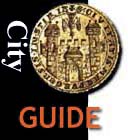
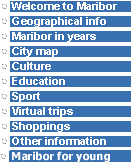
![]() Trg
revolucije - Tabor - Pekrska gorca -Radvanje- Betnava
Trg
revolucije - Tabor - Pekrska gorca -Radvanje- Betnava
On the right bank of the river Drava we begin with
our walk - we start 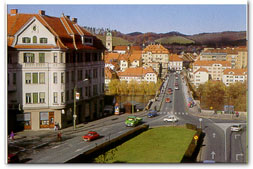 on Trg
revolucije (Square of the Revolution) which is
surrounded by some high buildings, built after First
World War. In this square four streets meet - Ruska
street on the west side, Dvorak street on the southwest,
Ljubljanska street on the southeast and Pobreska street
on the east side.
on Trg
revolucije (Square of the Revolution) which is
surrounded by some high buildings, built after First
World War. In this square four streets meet - Ruska
street on the west side, Dvorak street on the southwest,
Ljubljanska street on the southeast and Pobreska street
on the east side.
The way leeds us on Pobreska street to the the stairs which lead to the church of St.Magdalena. This church was first mentioned in 1289, but was burnt beetween 1498 and 1528. The tails of todays building are from diferrent periods - the church nave and the altar are from beggining of 17. century, the church tower, sacristy and north chapel are from 18. century. Till the 1821 the church was also rounded with cementery and the wall. On the northeast side we can see the city hospital and from here we go to Mosa Pijade street near the edge of Magdalena park, which stands on the location of Magdalena cementery, which was abandoned in 1906. On the other side of park stands ex army magazine with bakery. After the YU armade left this magazine, the bakery is today a kind of center for youth alternative culture.
On the Gorkega street we turn left and come to the old railway underpass. After that we come to the old railway settlement - a complex of buildins beetween Kurilniaska and Koresova street. The management of "Juzne zeleznice" ("Southern Railway Co.") began building a settlement for the workers in 1863. Till 1868 40 houses with 302 appartments were build and in the neighbourhood we find school and kindergarten. The inhabitants of this settlement had lived very isolated, because the railway company connected them with a place to live, school and with supply. This settlement has the same shape today that it had before.
On the other side of the settlement we find Sport center Tabor: here we they have a big hall for different performances, concerts etc., football playground, more smaller playgrounds, athletic stadium.
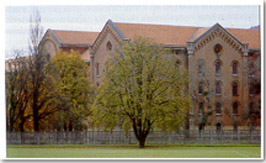 A hundred meters
souther we find on ex military academy, it is now used by
Slovenian army as the barracks.
A hundred meters
souther we find on ex military academy, it is now used by
Slovenian army as the barracks.
On the east side there is Pekrska gorca. The legend says that the Godfother wanted to punish the people of Maribor for their unbridled life. This is the story about origin of Pekrska gorca. So the Godfather had sent the Satan to punish the people. The Satan had broke off the top of the Pohorje and wanted to throw it into the Drava. He wanted the river Drava to overflow the town, but on his way he met St.Mary, the God's mother, and because of the fear he throw his load away and run into the night. The people of Maribor were very happy and thankfull, so they built in years 1832 - 1835 a little church of St.Mary. Near the church we can also find a Tcheligi crypt. From the east side a nice route with four chapels leads us to the church.
At the norhwest of Pekrska gorca we can see the remains of ski jump, built by the arch. Stanko Bloudek. East from Pekrska gorca stands a TV center Maribor.
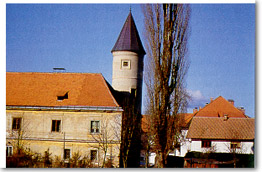 Our way leads us to Pohorje. We
stopped at 41, Lackova street - here we find Radvanje
castle, which is now very nice renewed. This castle was
first mentioned in 1695, was reconstructed in 1743 and got
the tower in 19. century. The castle has one floor and is
build in shape "L". Arcade halls are vaneted
crossly. Wraped marble staircaseare leading to the first
floor. On the south side of the castle we find a crypt. The castle is protected as
a historical monument.
Our way leads us to Pohorje. We
stopped at 41, Lackova street - here we find Radvanje
castle, which is now very nice renewed. This castle was
first mentioned in 1695, was reconstructed in 1743 and got
the tower in 19. century. The castle has one floor and is
build in shape "L". Arcade halls are vaneted
crossly. Wraped marble staircaseare leading to the first
floor. On the south side of the castle we find a crypt. The castle is protected as
a historical monument.
From the castle we go left to Lackova street to te
east. At the right side at the foot of the Pohorje were
brick-works - here the clay from the Pohorje brooks
were used. North from Lackova street we find an old
settlement Spodnje Radvanje. Not far from here stands a
Betnava castle. The first building of the castle was
built in renaissance (The Vicher engraving from 1681
proofs that). In 1587 a "freedom of religion"
was settled in Augsburg and in Betnava a protestant
church and cementery were built. Both were destroyed in
1600. The castle was burnt in 1685 and renewed in the
middle of 18. century. At this time the castle gets some
baroque characteristics. The castle is rounded with park
and an island. This island is "designed" by
water moat from Pekrski potok. The biggest tree in park
is plane-tree, which trunk extents 706 cm and is 35 m
high. One part of the castle is dedicated to wedding
ceremonies and the other part to shops and 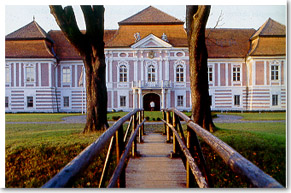 restaurants. At the north south
we find Betnava forrest, which is most popular with
people who live in the neighbourhood.
restaurants. At the north south
we find Betnava forrest, which is most popular with
people who live in the neighbourhood.
We come to the end of our tour. If you are not to tired you can go on foot to the city center (Ljubljanska street) or take the bus No. 2/1. From the Betnava castle we can also take the bus No. 11.